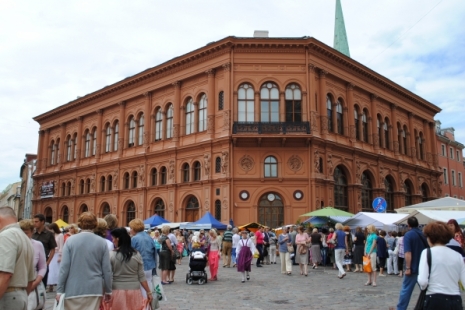The exhibition is devoted to the creative activities of the Riga-born Baltic German artist Georg Wilhelm Timm (1820–1895). The exhibition features more than 200 artworks from the collections of the Latvian National Museum of Art, Museum of the History of Riga and Navigation, and 19th century publications from the University of Latvia Academic Library.

Photo from Latvian National Museum of Art. Photo: Aigars Altenbergs
Georg Wilhelm Timm was born in the family of the burgomaster (mayor) of Riga, Friedrich Wilhelm Timm (1779–1848). At the age of 15 he entered the Saint Petersburg Academy of Arts, where he was a student in the battle painting class. On the suggestion of the French painter Émile Jean-Horace Vernet (1789–1863), in 1844 Wilhelm Timm went to France and in 1845 spent two months travelling around Algeria. On his return, artist commenced one of his most notable projects: he began publishing the periodical Русский художественный листок (Russian Art Gazette, 1851–1862). The works by Timm and other artists reproduced in this publication chronicled the current affairs that took place in Imperial Russia of that time – actual social, political and cultural events, the natural environment and people of various governorates. From 1867 onwards the artist lived in Berlin, working in the field of ceramics and experimenting with the painted decoration of porcelain and majolica. The Prussian Academy of Arts conferred upon him the honorary title of professor. Timm died in Berlin, but in 1898 his mortal remains were interred in the Great Cemetery of Riga.
A significant event in cultural life can be considered the fact that in 1904–1905 the artist’s widow Emilie Timm (nee Pfab, 1826–1906), and later also her heirs, gifted the artist’s works to museums in Riga. In order to foster the development of art in the Baltic, in 1906 Emilie Timm donated to the city of Riga a sum of money for the foundation of a Georg Wilhelm Timm Scholarship. Over the years 1907–1914 it was awarded to young Riga artists for the purpose of pursuing their studies abroad.
The basic conception of the exhibition is aimed at showing the most important aspects of Timm’s life and oeuvre. The exposition is made up of the following thematic cycles: In Russia, Travel Impressions, Back in the Homeland, Prints and Publication and Germany and Experiments in Ceramics. The content of five sections reflects the characteristic features of the master’s creative personality: his ability to perceive and portray the essence of a moment in life or a historical event, the precision and realism of depiction, his profound interest in nature and people, and also sense of humour and irony. The exhibition reveals two fundamental facets of Georg Wilhelm Timm’s creative output: a romantic inclination for seeking new impressions through travel, and a realistically rational view of life.
Museum has published the exhibition catalogue in Latvian, English and Russian.
Text by Ksenija Rudzīte
Project supported by:
State Culture Capital Foundation of Latvia, Rietumu Bank Charitable Foundation, GroGlass Ltd.
Participants in the project:
Latvian National Museum of Art, Museum of the History of Riga and Navigation,
University of Latvia Academic Library
Project leader and curator:
Ksenija Rudzīte, Curator of the Foreign Painting Collection, Art Museum RIGA BOURSE /
Latvian National Museum of Art
Curator:
Valentīna Opolā, Curator of the Foreign Graphic Art Collection, Art Museum RIGA BOURSE /
Latvian National Museum of Art
Project team:
Vita Birzaka, Līga Matsone, Kristīne Milere, Lilita Pudule, Vita Ozoliņa, Anna Emsiņa
Scenography of the exhibition:
Māris Ruskulis
Graphic design:
Kristīne Jansone
Restoration of prints, paintings and frames:
Una Kastanovska, Natālija Kurganova, Anna Kozorovicka
Painting and print design concept:
Arvils Vilkaušs
Exhibition’s construction:
Rūdolfs Cunskis, Aivars Priedītis
Galerii nimi: Art Museum RIGA BOURSE
Address: Doma laukums 6, Central District, Rīga, Latvia
Opening hours: Tue-Thu 10:00 - 18:00 Fri 10:00 - 20:00 Sat-Sun 10:00 - 18:00
Open: 15.01.2022 — 03.04.2022
Address: Doma laukums 6, Central District, Rīga, Latvia
Opening hours: Tue-Thu 10:00 - 18:00 Fri 10:00 - 20:00 Sat-Sun 10:00 - 18:00
Ticket info: Adults: 3,50 EUR Pupils, students, seniors: 2,00 EUR Family ticket (1–2 adults with 1–4 children or family having many children): 5,00–7,00 EUR
Open: 15.01.2022 — 03.04.2022
